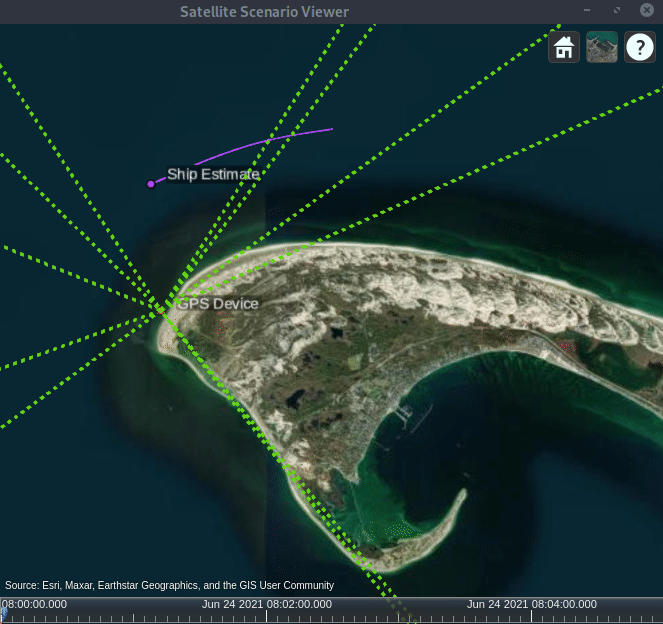Tracking with Angle-Only, Bistatic, and Time-of-Arrival Sensors
These examples track targets using sensors of limited observability, such as range-only, angle-only, and time-of-arrival sensors.
Featured Examples
Multistatic Localization of a Ship Using GPS Illuminations
Examines locating and rescuing a ship that gets lost a few kilometers north of Cape Cod during the night. A rescue team stationed at a nearby lighthouse aims at locating the ship. Equipped with a Global Positioning System (GPS) device capable of accessing GPS satellites, they utilize the device to receive GPS signals reflecting off the ship, enabling them to pinpoint its location.
- Since R2025a
- Open Live Script
Tracking Using Bistatic Range Detections
Simulate bistatic range-only detections using four sensor-emitter pairs. In addition, this example demonstrates how to localize and track multiple targets using bistatic range-only measurements.
Object Tracking Using Time Difference of Arrival (TDOA)
Track objects using time difference of arrival (TDOA). This example introduces the challenges of localization with TDOA measurements as well as algorithms and techniques that can be used for tracking single and multiple objects with TDOA techniques.
- Since R2022a
- Open Live Script
Vehicle Tracking for Urban Air Mobility Using 5G Position Reference Signal
Use 5G signals to track unmanned aerial vehicles (UAVs) for urban air mobility applications. This example considers that the ground stations are equipped with 5G devices to track the UAVs carrying 5G devices. You can simulate 5G signals in this environment and use them to estimate the time of arrival (TOA) of the signals at each UAV. Furthermore, you can use a multi-object tracking algorithm to process the TOA estimates to localize and track the UAVs.
- Since R2023b
- Open Live Script
Asynchronous Angle-only Tracking with GM-PHD Tracker
Track objects using angle-only measurements from spatially distributed and asynchronous passive sensors.
- Since R2022b
- Open Live Script
Angle-Only Tracking with Passive Scanning Sensors
Track multiple targets and create a maritime situational picture with passive sensors. Passive sensors are sensors that do not emit any energy towards their target and rely solely on emissions from the targets for detection. Therefore, passive sensors cannot provide a full position measurement of the detected target. In this example, the passive sensors you use are infrared sensors that scan the region of interest and provide angle-only detections of the targets.
- Since R2023b
- Open Live Script
Tracking Using Distributed Synchronous Passive Sensors
Illustrates the tracking of objects using measurements from spatially-distributed and synchronous passive sensors. In the Passive Ranging Using a Single Maneuvering Sensor, you learned that passive measurements provide incomplete observability of a target's state and how a single sensor can be maneuvered to gain range information. Alternatively, multiple stationary sensors can also be used to gain observability. In this example, you will learn how to track multiple objects by fusing multiple detections from passive synchronous sensors.
802.11az Three-Dimensional Tracking Using Time of Arrival Estimation
Use an IEEE 802.11az Wi-Fi network to track Wi-Fi devices in a three-dimensional space using time of arrival (TOA) estimation.
- Since R2024b
- Open Live Script
Source Localization and Tracking with Passive Receivers
A passive source localization (PSL) sensor network consists of spatially distributed passive sensors to detect, localize, and track target emitters. The passive sensors are non-transmitting receivers and hence are covert and low-cost. These benefits make PSL sensor networks attractive in many applications, such as air surveillance, acoustic source localization, etc. This example shows how to localize and track targets in a PSL sensor network.
- Since R2024b
- Open Live Script
MATLAB Command
You clicked a link that corresponds to this MATLAB command:
Run the command by entering it in the MATLAB Command Window. Web browsers do not support MATLAB commands.
Select a Web Site
Choose a web site to get translated content where available and see local events and offers. Based on your location, we recommend that you select: .
You can also select a web site from the following list
How to Get Best Site Performance
Select the China site (in Chinese or English) for best site performance. Other MathWorks country sites are not optimized for visits from your location.
Americas
- América Latina (Español)
- Canada (English)
- United States (English)
Europe
- Belgium (English)
- Denmark (English)
- Deutschland (Deutsch)
- España (Español)
- Finland (English)
- France (Français)
- Ireland (English)
- Italia (Italiano)
- Luxembourg (English)
- Netherlands (English)
- Norway (English)
- Österreich (Deutsch)
- Portugal (English)
- Sweden (English)
- Switzerland
- United Kingdom (English)

